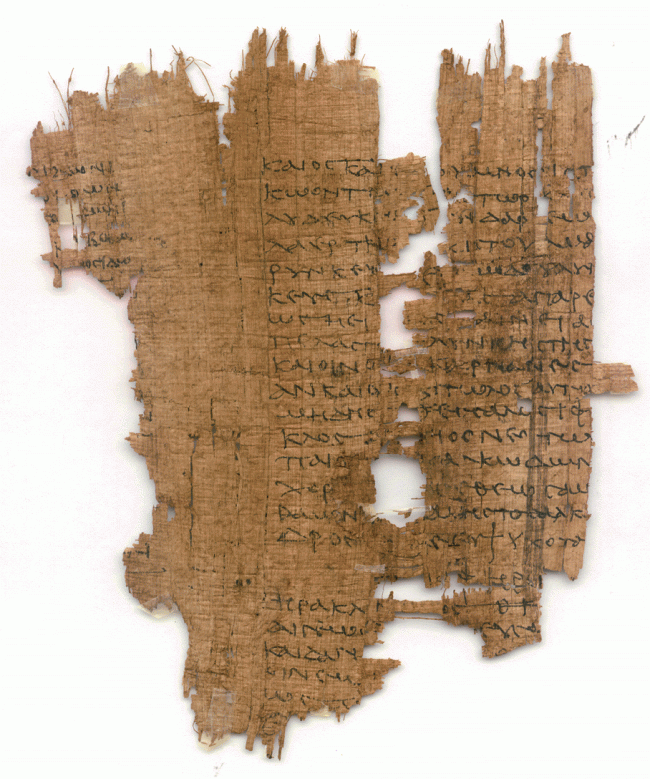Papyrus and Education in Antiquity I
Dear Ancient Lives Users,
First off, apologies for the lateness of this post. It’s been a tough month as we’ve all transitioned from the business of finishing up the spring semester to the business of starting up our various summer projects. (Most excitingly, for one of us this transition involved heading off to Greece to spend the summer on an archaeological dig.)
—–
The existence of the papyri that we have and love presupposes an obvious fact: that people knew how to write. This is an easy fact to take for granted when many of us live in countries where education is compulsory and literacy rates are high. But taking this fact for granted precludes some interesting questions about the world in which the papyri were written: for example, how and when did people learn to write?
Ancient literary sources do tell us a fair amount about the nature of ancient education. For example, Dionysius of Halicarnassus, a first-century BCE Greek historian and rhetorician tells in his On the Composition of Words how students were first taught the shape, sound, and name of the letters of the alphabet, then how to put those letters together into syllables, syllables into words, words into sentences, sentences into connected passages, and so on till they were accomplished readers. And once they were comfortable reading syllables at least, students began to learn to write via a similar curriculum.
Other Greek and Roman authors such as Plato and Quintilian, a first-century AD Roman rhetorician known principally from his Institutes of Oratory, which discusses extensively the theory and practice of oratory as well as the education of the orator, largely corroborate the shape of the ancient curriculum. And Plutarch advises us in his On the Training of Children, when our children first reach a certain young age, to avoid pedagogues (primary teachers) who are cheats and drunkards. Plutarch’s focus in this essay is on the moral education of children, so he has nothing much to say about the practice of learning to write, but we do get from him the idea that in some circles at least one’s education began early as a child. Altogether then the literary sources gave us a picture of a certain progressive curriculum begun, at least in some circles, at an early age. But before the discovery of all the papyri we mostly (we do have some ostraka, pot sherds or bits of limestone with writing on them, and writing tablets preserved) lacked direct evidence of the mundane, day-to-day details of this preliminary education.
Thanks in large part to papyrological evidence we know that, because first and foremost students needed to know how to write, that this is evidently what they learned in the first of the three stages of a complete education; the second and third involved advanced study of poetry and prose. The first exercises that students undertook were writing individual letters of the alphabet in no particular order and then writing letters in order. Eventually students went on to practice writing syllables, lists of words, sentences, short passages, and finally longer passages.
Students had, then as now, poor handwriting when they began their studies, but after much practice were able to write more neatly. We know from the distribution of hands in our surviving examples that some of these activities were done only by beginning or intermediate students, others only by advanced students. For example, we only find examples of practice with individual letters in the beginners’ handwriting, while no examples of long passages are written in a beginner’s handwriting for obvious reasons. Other exercises, such as writing lists of words and short maxims, were done by all students, but mostly by intermediate ones: beginners lack the skill to do this much and advanced students would only need to do so occasionally to hone further their handwriting skills. (You can imagine that you might observe a similar distribution if you gathered together all the examples of student writing from a contemporary primary school.)
All that being said, here are some examples of such exercises:
Here is a 2nd-century BC (?) example where someone has attempted to write the letters of the alphabet in order (P.Mich.inv.3197):
If you’re familiar with the Greek alphabet, you’ll notice that the writer here has missed the letter Z between E and H. In addition to this mistake, the letters are sloppy, irregularly sized, and not in line. And notice how the writing goes against the grain of the papyrus: beginning students often had to make do with the backs of used documents or little scraps, since good, unused papyrus was wasted on them.
Here is a 6th-century wooden table on which someone has practiced writing syllables (P.Duk.inv. 232):
Notice the relatively nice but still not expert handwriting. It is one of the anomalies of surviving school exercises that practice with syllables, while it seems it would be beginner’s work, is only done evidently by more advanced students.
And here we have a 3rd-century list of the participants of the Caldonian Boar Hunt (P.Duk.inv. 752):
Bibliography
Cribiore, Raffaela. 1996. Writing, teachers, and students in Graeco-Roman Egypt. Atlanta: Scholars Press.
–. 2001. Gymnastics of the Mind: Greek Education in Hellenistic and Roman Egypt. Princeton: Princeton University Press.
Marrou, Henri-Irénée. 1982. A History of Education in Antiquity. Madison: University of Wisconsin Press.



